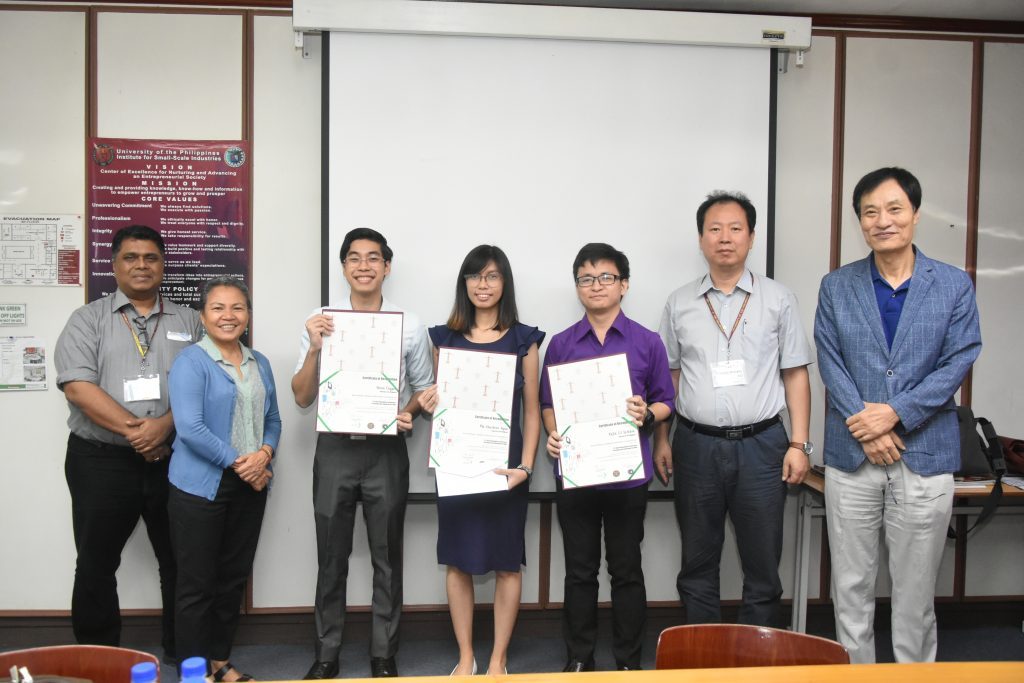We live in an age where science and technology is just within our reach, changing the way we do things and making our lives so much easier.
So when the younger generation, with their wit and grit and the passion to make a difference, harnesses the power of science and technology, what do we get? Innovations that will change our lives and the society for the better.
On the last day of the ASIP Conference, three students from UP Diliman College of Engineering presented their innovative concepts that could help SMEs and the society, in general.

Cloop: Disrupting the recycling industry
Glenn Adrian Ongpin talked about “Cloop”, a start-up company that develops plastics recycling technology and makes it accessible to underserved communities.
Cloop aims to help communities, such as those in urban dumpsites and coastal areas, which do not have proper waste management system because of lack of access to large recycling facilities (as these require large amounts of investment).
Cloop develops a package of four recycling machines: a shredder, an extruder, an injection molder, and a compression molder. It aims to create a network of micro-enterprises and SMEs specializing in upcycling plastic waste operating in areas that need it the most.
Cloop (formerly InPHinite Loop) started as a one-time activity called “Project Plastikan” under the UP Diliman Humanitarian Engineering, Entrepreneurship, and Design Group which aimed to help a women’s community in Malabon have sustainable income by providing plastic recycling machines.
Ongpin co-founded Cloop with two of his friends who were also involved with Project Plastikan partners.
Rethinking wastewater treatment
Miguel Lawrence Keith SJ. Celebre discussed about the technology he is currently working on, which treats textile wastewater for methylene blue and other cationic dyes.
Methylene blue (MB) is a non-biodegradable synthetic dye that is widely used in the textile industry. It has a very strong color even in dilute concentrations. The textile and dyeing industries are some of the most water-intensive industries globally, producing approximately 100 tons of dye-contaminated wastewater per year — the highest amount produced by one industry alone. If discharged to the environment untreated, dye-contaminated wastewater poses health and environmental threats. Further, the presence of color in bodies of water reduces the amount of transmitted light that is available for use of photosynthesizing aquatic organisms like plants, algae, and bacteria.
Celebre said “polymeric adsorbent beads”, the technology he is working on, was found to have a maximum MB sorption capacity of 1081.62 milligrams of MB per gram of adsorbent. This is higher compared to other adsorbents for MB that have been studied for the past six (6) years, the adsorption capacities of which are only around the hundreds. Kinetic studies were also conducted, and it was found that the beads only require 2.5 hours to reach equilibrium—the state where there is no longer any observed removal of MB.
With this technology, operating costs can be reduced by recycling of the purified water and costs for third-party wastewater treatment will be cut down almost entirely. MB will be sequestered in the adsorbent and can be stored until time for disposal or treatment, without any risk of fugitive MB emissions.
Exploring potential treatments for kidney stone disease
While the first two technologies focus on the environment, Ma. Charlene C. Tapia’s innovative concept aims to respond to the increasing incidence of kidney stone disease (nephrolithiasis), particularly the calcium phosphates (CaP) stones.
Tapia explained that while the current commercially available medication is able to slow down the growth of these stones, it can however increase urine pH, a condition in which the most stable form of CaP is formed.
She said her project aimed to explore for other possible inhibitors that will prevent the increasing occurrence of kidney stones and allow more choices of treatments for patients.
Tapia then explained that based on earlier studies and her initial experiments, hydroxycitrate (HCA) was found to be an effective inhibitor. Found in some plants such as Garcinia cambogia and Hibiscus sabdariffa, HCA can change the shape of the crystal, reduce the number of crystals formed and can even dissolve the CaP crystal.
Tapia said that the results of her study may serve as a step in understanding the effect of HCA on CaP crystals and to aid SMEs in designing formulation of drugs or food supplements targeting kidney stone disease.

The three students presented their projects to a panel composed of ASIP President Prof. Sung-Soo Seol, Prof. Mohan Avvari of Nottingham University, Prof. Chi Renyong of Zhejiang University of Technology and UP ISSI Director Aleli Bawagan.
The panel members commended the students for their innovative projects and the potential impact they can create in society. Prof. Seol and Prof. Chi advised the students to work with partners for the sustainability of their projects. Prof. Avvari advised the students to explore funding outside the Philippines. Director Bawagan mentioned about UP ISSI’s incubation program as a next step the students may consider.
Report from ASIP documentation team
Related articles:
ISSI, ASIP Organize International Conference on Technology and Innovation
ISSI Shares Innovative Approaches to Entrep Educ, Farm Tourism
Recap of 2019 ASIP Manila Conference on “Technology and Innovation for SMEs”
Disclaimer: The views expressed herein or in any article in the UP ISSI website are those of the authors and do not necessarily reflect the policies or opinions of UP ISSI nor the views of the University of the Philippines. Regarding Accuracy of Information and Usage of Data: Visitors and users of the UP ISSI website are advised that information contained within the website is assumed to be accurate. However, errors can occur even with computer-generated information. UP ISSI makes no representation regarding the completeness, accuracy, or timeliness of such information and data, or that such information and data will be error-free. Visitors are encouraged to review the official version of all documents on which they plan to rely on.